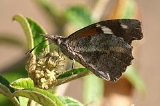
Snout butterfly
Encyclopedia
The American Snout or Common Snout Butterfly (Libytheana carinenta) is a member of the Libytheinae
subfamily, in the brush-footed butterfly family
Nymphalidae
. This species
is found in both North and South America. The larval host plants are Celtis spp. on which the eggs are laid singly. Massive migrations of this species often attract attention in the Texas and Mexican newspapers.
 Snout butterflies have prominent elongated mouthparts (labial palpi) which, in concert with the antennae
Snout butterflies have prominent elongated mouthparts (labial palpi) which, in concert with the antennae
, give the appearance of the petiole
(stem) of a dead leaf. Snouts often take advantage of their brilliant camouflage
by hanging upsidedown under a twig, making them nearly invisible. Wings are patterned black-brown with white and orange markings. The fore wings have a distinctive squared off, hook-like (falcate) tip. Caterpillars appear humpbacked, having a small head, swollen first and second abdominal segments, and a last abdominal segment that is tapered and rounded. They are dark green with yellow stripes along the top and sides of the body, and have two black tubercles on the top of the thorax
.
Libytheinae
Libytheinae is the nymphalid subfamily of the snout butterflies, containing two valid genera and about 10 species, 6 in Libythea and 4 in Libytheana. The common name refers to the thick labial palps that look like a "snout" in this subfamily. In older literature, this group was recognized as the...
subfamily, in the brush-footed butterfly family
Family (biology)
In biological classification, family is* a taxonomic rank. Other well-known ranks are life, domain, kingdom, phylum, class, order, genus, and species, with family fitting between order and genus. As for the other well-known ranks, there is the option of an immediately lower rank, indicated by the...
Nymphalidae
Nymphalidae
The Nymphalidae is a family of about 5,000 species of butterflies which are distributed throughout most of the world. These are usually medium sized to large butterflies. Most species have a reduced pair of forelegs and many hold their colourful wings flat when resting. They are also called...
. This species
Species
In biology, a species is one of the basic units of biological classification and a taxonomic rank. A species is often defined as a group of organisms capable of interbreeding and producing fertile offspring. While in many cases this definition is adequate, more precise or differing measures are...
is found in both North and South America. The larval host plants are Celtis spp. on which the eggs are laid singly. Massive migrations of this species often attract attention in the Texas and Mexican newspapers.

Antenna (biology)
Antennae in biology have historically been paired appendages used for sensing in arthropods. More recently, the term has also been applied to cilium structures present in most cell types of eukaryotes....
, give the appearance of the petiole
Petiole (botany)
In botany, the petiole is the stalk attaching the leaf blade to the stem. The petiole usually has the same internal structure as the stem. Outgrowths appearing on each side of the petiole are called stipules. Leaves lacking a petiole are called sessile, or clasping when they partly surround the...
(stem) of a dead leaf. Snouts often take advantage of their brilliant camouflage
Camouflage
Camouflage is a method of concealment that allows an otherwise visible animal, military vehicle, or other object to remain unnoticed, by blending with its environment. Examples include a leopard's spotted coat, the battledress of a modern soldier and a leaf-mimic butterfly...
by hanging upsidedown under a twig, making them nearly invisible. Wings are patterned black-brown with white and orange markings. The fore wings have a distinctive squared off, hook-like (falcate) tip. Caterpillars appear humpbacked, having a small head, swollen first and second abdominal segments, and a last abdominal segment that is tapered and rounded. They are dark green with yellow stripes along the top and sides of the body, and have two black tubercles on the top of the thorax
Thorax
The thorax is a division of an animal's body that lies between the head and the abdomen.-In tetrapods:...
.
External links
- Tree of Life Libytheinae
- American Snout Butterfly: Reference quality large format closeup photographs Cirrus Digital Imaging
- American snout on the UFUniversity of FloridaThe University of Florida is an American public land-grant, sea-grant, and space-grant research university located on a campus in Gainesville, Florida. The university traces its historical origins to 1853, and has operated continuously on its present Gainesville campus since September 1906...
/ IFASInstitute of Food and Agricultural SciencesThe University of Florida’s Institute of Food and Agricultural Sciences is a federal-state-county partnership dedicated to developing knowledge in agriculture, human and natural resources, and the life sciences, and enhancing and sustaining the quality of human life by making that information...
Featured Creatures Web site - American Snout, Butterflies of Canada

